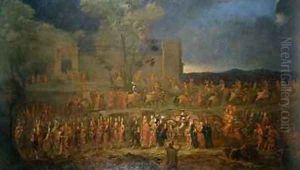Jean-Baptiste Van Mour Paintings
Jean-Baptiste Van Mour, also known as Jean-Baptiste Vanmour, was a Flemish-French painter renowned for his vivid and detailed depictions of the Ottoman Empire. Born on January 9, 1671, in Valenciennes, which was then part of the Spanish Netherlands, he developed an interest in painting at a young age. Van Mour's artistic journey led him to Paris, where he honed his skills and became influenced by contemporary French art. His life took a significant turn when, in 1699, he was invited to the Ottoman Empire by the French ambassador, Charles de Ferriol. This opportunity arose from the ambassador’s desire to document life and customs in the empire, and Van Mour's skills made him an ideal candidate for this task.
Upon his arrival in Constantinople (modern-day Istanbul), Van Mour was captivated by the vibrant life, architecture, and people of the Ottoman Empire. He dedicated the next 38 years of his life to painting scenes of daily life, court ceremonies, and portraits of Ottoman dignitaries, European visitors, and ambassadors. His work provides an invaluable visual record of the social and diplomatic interactions between the Ottoman Empire and Europe during the early 18th century. Van Mour's style, characterized by its attention to detail, vivid colors, and the ability to capture the subtleties of facial expressions and emotions, made him a sought-after artist among the European elite residing in or visiting Constantinople.
Jean-Baptiste Van Mour's legacy is a significant collection of paintings that serve as historical documents offering insights into the complexities of Ottoman-European relations and the cultural life of the Ottoman Empire. Notably, his series of 100 portraits commissioned by de Ferriol to illustrate the dress and customs of the Empire's inhabitants were later engraved and widely distributed in Europe, further cementing Van Mour's impact on Western perceptions of the Ottoman world. He passed away in Constantinople on January 22, 1737, leaving behind a body of work that continues to be studied and admired for its artistic and documentary value. Through his paintings, Jean-Baptiste Van Mour not only bridged cultural and geographical divides but also preserved a fascinating era of history with enduring appeal and relevance.
